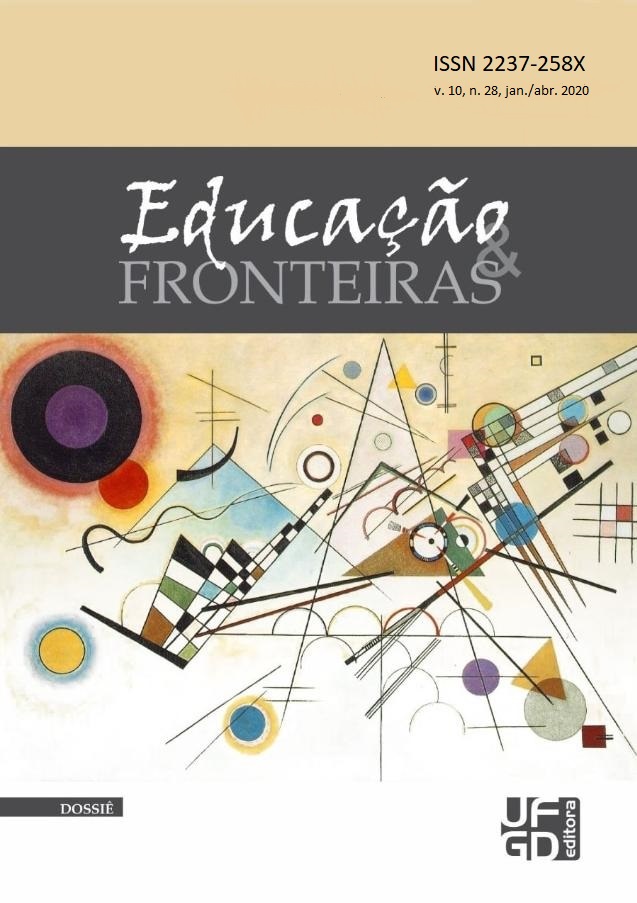The audiodescription and the visual elements of the spectacle
DOI:
https://doi.org/10.30612/eduf.v10i28.13024Keywords:
Audiodescription. Arts of the Scene. Cultural Accessibilit.Abstract
Audio-description (AD) is a resource that is gradually being studied, researched and operationalized in a perspective of cultural inclusion, providing the access and enjoyment of people with disabilities to various cultural products / spaces. Assuming that theater, dance, the visual arts, cinema, circus, performance, television programs, and other cultural goods / products are assets to which everyone must have access; and the questions: how to determine which elements should be prioritized? What to keep and what to suppress in detriment of time? What is the aesthetic function of these audiodescribed elements and how to describe them?; we propose to reflect on the visual elements of the show, their functions and possibilities of verbal translation, thus broadening the understanding of the narrative by visually impaired people. We propose, therefore, notes for the description of the visual elements of the spectacle, making them verbal, using theorists of the scene arts and taking into account the constituent elements of the scene, its multiplicity and complexity.Downloads
References
CAMARGO, Roberto Gill. Função estética da luz. 2. ed. São Paulo: Perspectiva, 2012.
HOBI, Larissa. Interface Cena e Tecnologia: composições cênicas mediadas. 2013. 130f. Dissertação (Mestrado em Artes Cênicas) – Universidade Federal do Rio Grande do Norte, Natal, 2013.
HOBI, Larissa. Elementos Visuais do Espetáculo: apontamentos para elaboração de audiodescrição. 2015. 85f. Trabalho de conclusão de curso (Especialização) – Universidade Federal de Juiz de Fora, Juiz de Fora, 2015.
HURTADO, C. J. (ed.). Traducción y accesibilidad. Subtitulación para sordos y audiodescripción para ciegos: nuevas modalidades de Traducción Audiovisual. Frankfurt AM Main: Peter Lang, 2007.
MOTTA, Lívia Maria Villela de Mello; ROMEU FILHO, Paulo (org.) Audiodescrição: transformando imagens em palavras. São Paulo: Secretaria de Estado da Pessoa com Deficiência, 2010.
MURRAY, Janet H. Hamlet no holodeck: o futuro da narrativa no ciberespaço. São Paulo: Itaú Cultural: Unesp, 2003.
PAVIS, Patrice. A Encenação contemporânea: origens, tendências, perspectivas. São Paulo: Perspectiva, 2010.
PAVIS, Patrice. A análise dos espetáculos. São Paulo: Perspectiva, 2005.
ROUBINE, Jean-Jacques. A linguagem da encenação teatral, 1880 - 1980. 2. ed. Rio de Janeiro: Jorge Zahar, 1998.
RYNGAERT, Jean-Pierre. Introdução à análise do teatro. São Paulo: Martins Fontes, 1995.
RYNGAERT, Jean-Pierre. Ler o teatro contemporâneo. 2. ed. São Paulo: Martins Fontes. 2013
SARRAZAC, Jean-Pierre (Org.). Léxico do drama moderno e contemporâneo. São Paulo: Cosac Naify, 2012.
SASSAKI, Romeu Kazumi. Inclusão: acessibilidade no lazer, trabalho e educação. Revista Nacional de Reabilitação (Reação), São Paulo, Ano XII, mar./abr. 2009, p. 10-16.
SASSAKI, Romeu Kazumi. Sete Dimensões da Acessibilidade. Palestra Pessoas com deficiência no mercado de trabalho e acessibilidade, Curitiba, 2012.
UBERSFELD, Anne. Para ler o teatro. São Paulo: Perspectiva, 2005. Disponível em: http://www.vercompalavras.com.br / http://www.blogdaaudiodescricao.com.br/. Acesso em: 08 de jan.de 2016.









